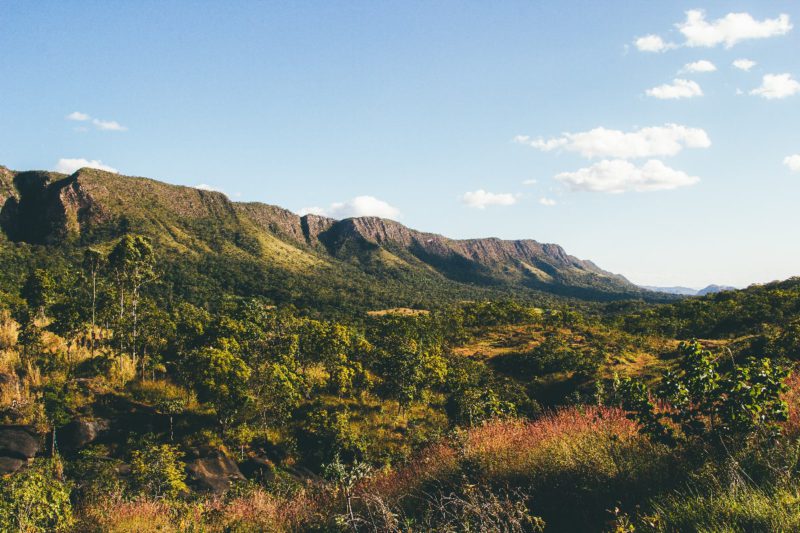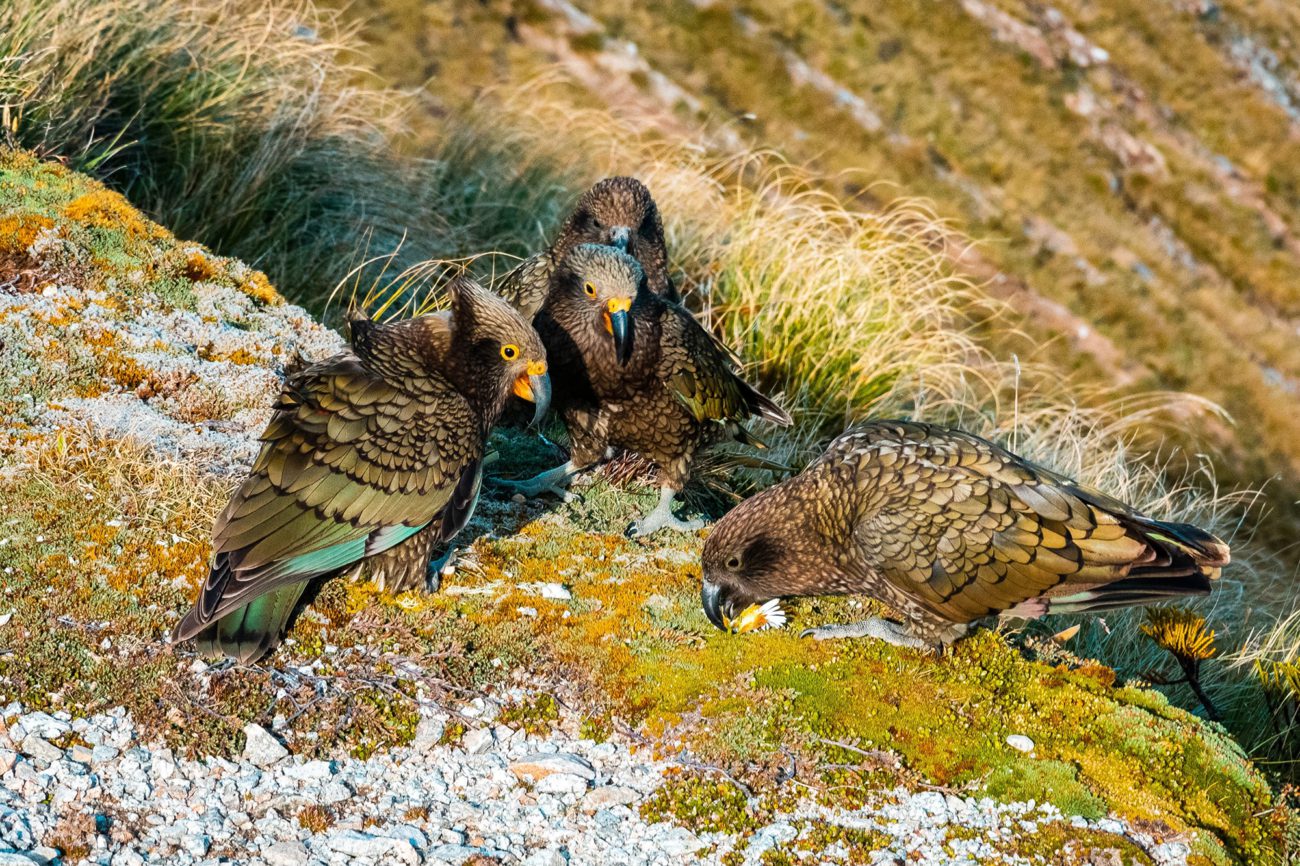The Brazilian national parks system quietly holds some of the world’s most impressive natural wonders. Yawning valleys, monumental waterfalls, ancient forests, and other remnants of Mother Nature’s handiwork dot the diverse Brazilian landscape, and their parks exist to protect them. With less infrastructure than their United States counterparts, stepping into one of the Brazilian national parks is like stepping back in time to an era when the wilderness was left wild.
There are a total of 72 Brazilian national parks, and most require a relatively large time commitment to explore. This can make it relatively overwhelming to decide which parks to visit while in the country. But hey, that’s what we’re here for! Here’s a quick look at some of the finest Brazilian national parks to inspire that feeling of wanderlust in you.
Itatiaia National Park
What better place to begin a survey of Brazil’s national parks than Itatiaia? Designated all the way back in 1937, it’s the first national park in the country, and it offers a glimpse into the untamed, wonderful landscapes that define Brazil’s wilderness areas. Lush forests, craggy mountains (including the gorgeous Pico das Agulhas Negras, Brazil’s third-highest peak), flowing waterfalls, and abundant wildlife make the park a nature enthusiast’s dream.
What is there to do in the park? Hiking is one of the preferred activities, with some of the trails climbing up in elevation to the tops of the park’s mountains. Morro do Couto, a hill near the park entrance, is a popular choice, but easier trails like the Cachoeira das Flores offer great views and the chance to feel immersed in the environment without expending too much effort. The park is only about a 2.5-hour drive from Rio de Janeiro, so definitely consider putting it on your Brazil to-do list!
Iguaçu National Park
Found in southern Brazil on the country’s border with Argentina is Iguaçu National Park. The park is chiefly known for one thing: Iguaçu Falls. Considered the world’s largest system of waterfalls, Iguaçu Falls is an otherworldly sight. 275 individual waterfalls make up the system, and water cascades down nearly a 300-foot drop, creating a scene of white mist and rushing rapids that’s impossible to look away from. Seriously, the falls will absolutely dominate your view – they’re that gargantuan.
There are multiple ways to enjoy the falls from Brazil’s side of the park. You can admire from afar, take a boat out into the river to get up close and personal with the falls, or even walk out onto a catwalk that positions you right below the action. Of course, the falls themselves are only a small portion of the protected area that constitutes the park, so other adventures await such as walks through the jungle, wildlife tours, and biking excursions.
Jaú National Park
If you want a truly authentic Amazonian experience, there are few destinations better than Jaú National Park. The park is made up of nearly 6 million acres of pristine rainforest, and three of Brazil’s major rivers (the Jaú, the Unini, and the Carabinani) are found here. For the most part, it is undoubtedly dense, difficult land — the friendly, accessible feel of the U.S. national parks system, for instance, isn’t found here. But that’s part of the appeal.
When you visit Jaú National Park, you are truly entering another world. This is nature in its purest form: diverse wildlife, incomprehensibly lush foliage, starry skies, rushing water, and quiet moments. Planning a visit isn’t always simple, as you can’t just drive up and start exploring. Many travelers work with guide services in Manaus, the closest city, to arrange a visit. Much of the travel within the park is accomplished with motor boats and canoes, and you’ll have the chance to spot animals like crocodiles, tapirs, jaguars, and more.
Tijuca National Park
Tijuca National Park might just be the least likely of all Brazilian national parks. In a massive country covered in untouched rainforest, you would think that every park would be located as far as possible from the nearest city. Tijuca, though, is directly in Rio de Janeiro, Brazil’s busiest burg. You can spend half the day in the national park and be back in the city for lunch and drinks in less than an hour. Talk about convenience!
Naturally, many of the attractions in Tijuca skew towards the urban or human-made. The most iconic example of this is certainly Christ the Redeemer, the famous statue that towers more than 100 feet above the summit of Mount Corcovado. However, as the world’s biggest urban rainforest, Tijuca also offers plenty of genuine nature experiences. Hiking trails through the hills, waterfalls, and abundant animal life can all be spotted here — and it’s all just a stone’s throw away from your hotel in downtown Rio.
Chapada Diamantina National Park
Expansive views, careening cliffs, waterfalls big enough to boggle the mind — these are the sights you can expect at Chapada Diamantina National Park. Sounds pretty great! But… why do so few tourists go there?! While the beauty of Chapada Diamantina is well known in Brazil, international travelers rarely hear about it thanks to the fact that it’s nowhere near tourist hubs like Rio or São Paulo. Don’t let that fool you, though: the locals love this park for good reasons.
The massive size of this park means that there’s an endless list of wonders to explore. Most travelers hop on a bus in Salvador and head to the gateway town of Lençóis to book tours and enter the park. You can visit a deep blue underground swimming hole, hike to Brazil’s second-tallest waterfall (it drops a dizzying 340 meters), or even book a guided multi-day trek through Vale do Pati to see panoramic views of the park. This is a true natural paradise.
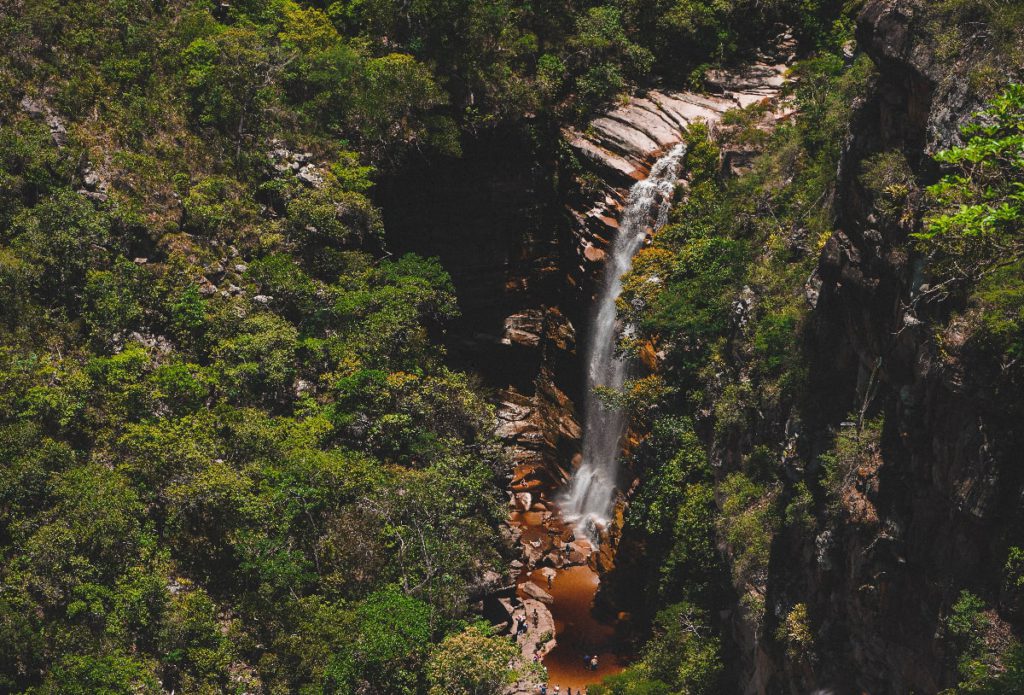
Lençóis Maranhenses National Park
Lençóis Maranhenses is unlike any other national park in Brazil. In fact, it’s probably nothing like the image that first comes to your mind when you think of Brazilian national parks. The dense and humid rainforests that the country is known for are nowhere to be found here. Instead, the landscape of Lençóis Maranhenses is dominated by sweeping, golden sand dunes interrupted by shallow pools of glittering water. It’s not your typical Brazilian scene, but its stark beauty is breathtaking. Hiking, swimming, sliding down the dunes… there are plenty of ways to interact with this remarkable environment.
Lençóis Maranhenses National Park is found in northern Brazil in the state of Maranhão. The closest city is São Luís, and many tours can be organized from here. However, if you want to stay closer to the park, Barreirinhas is the best option. The small town is only a short ways outside of Lençóis Maranhenses, and it’s an authentic peek into Brazilian culture.
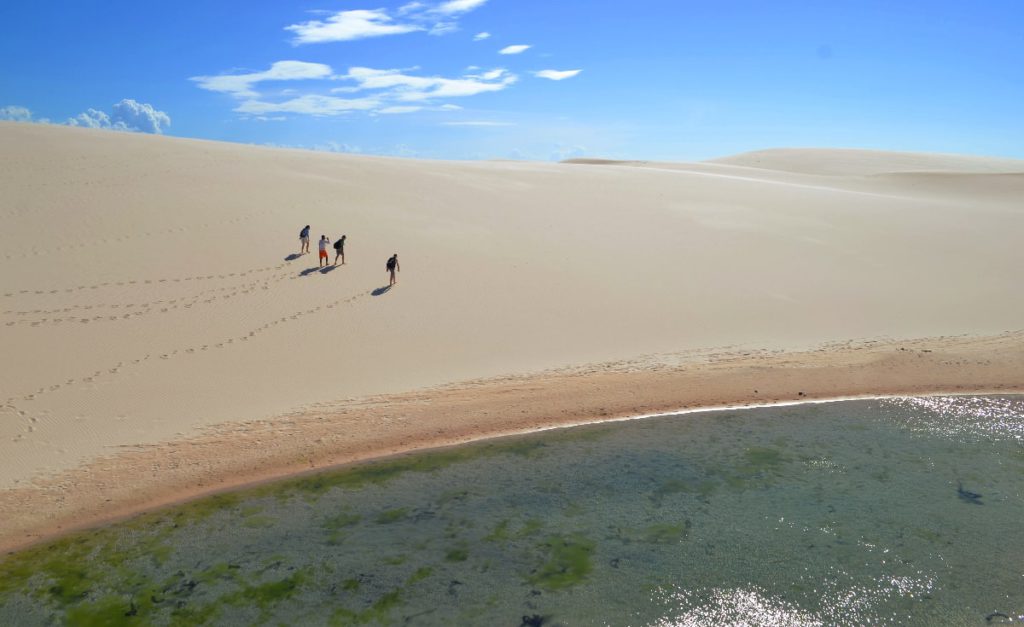
Chapada dos Veadeiros National Park
Another Brazilian national park that deserves a spot on your travel bucket list is Chapada dos Veadeiros National Park. Located near the cute town of Alto Paraíso de Goiás, Chapada dos Veadeiros is a scene of rolling green hills, tumbling valleys, and waterfalls. Lots and lots of waterfalls. Some fall more than 100 meters from the tops of sheer bluffs, creating clouds of mist, while other, smaller falls serve as a backdrop for placid swimming holes.
In the unlikely event that you get tired of hikes to gorgeous waterfalls, another area near Chapada dos Veadeiros National Park is certainly worth a stop. Vale da Lua, a geologic wonderland, is just outside of the park proper. It’s made up of surreal rock formations that have been carved by rushing water over millennia. A visit to Vale da Lua feels like stopping at another planet!
Serra dos Órgãos National Park
It’s not an exaggeration to say that you have never seen mountains like the ones in Serra dos Órgãos National Park. The third national park to be created in Brazil, Serra dos Órgãos is home to mind-blowing spires of granite that stretch towards the sky like fingers. (There’s a reason the park’s most famous peak is called Dedo de Deus… God’s Finger.) These unique peaks are said to resemble church organs, giving the entire landscape a reverent beauty that is found nowhere else.
Naturally, the mountains of Serra dos Órgãos attract a highly adventurous crowd. Climbers come from around the world to bag the summits here. Luckily, technical skill isn’t required to enjoy the park — day hikes in the shadows of the spires are incredibly fun, and the park’s relative proximity to Rio means that a visit doesn’t need to be a huge time commitment. The Postal Card Trail, for instance, is a popular trek that only takes about two hours and finishes with fantastic views.
Anavilhanas National Park
Remote and untamed, Anavilhanas National Park is another stunning sector of the Amazon that will appeal to those who truly want to get out and explore nature. You won’t find the typical national park experience of manicured trails and gift shops here; instead, you’ll find an endless rainforest ecosystem beside the Rio Negro, a uniquely beautiful river that snakes through the park.
Your experience in the park will vary greatly depending on the season. In the dry season, the river recedes and exposes magnificent beaches on the edges of the various islands. The wet season, however, floods most of the land, creating a scene of vegetation rising directly out of the black water of the Rio Negro. It’s not the easiest park to explore, but a tour booked in Manaus is certainly worth it for those who want an authentic and adventurous Amazonian experience.
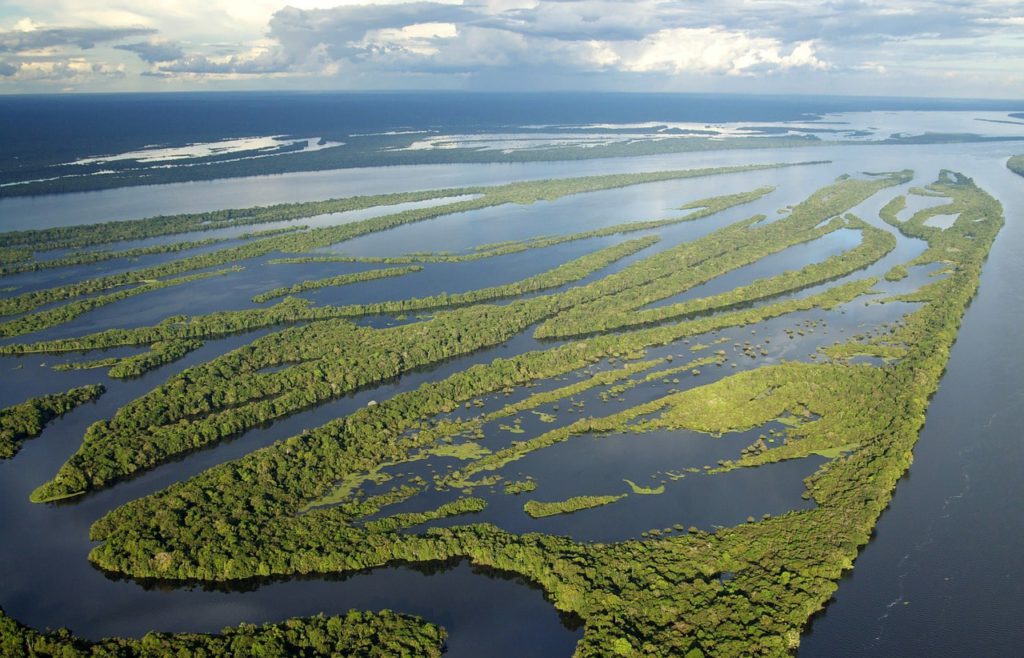
Chapada dos Guimarães National Park
Chapada dos Guimarães National Park has something for everyone. Are you into geology? The ancient sandstone cliffs that rise dramatically above the valley floor will certainly interest you. An animal lover? Some of Brazil’s most fantastic species can be found here, like monkeys, jaguars, and parrots. Got an obsession with geography? Chapada dos Guimarães sits directly in the geographic center of South America, symbolizing a divide between distinct ecosystems. Put shortly, this park is nothing short of fascinating.
All of this aside, the main draw to Chapada dos Guimarães is the hiking. Trails move through a labyrinth of towering waterfalls and vibrant forests on the valley floor, creating a scene that at once feels both completely unique and quintessentially Brazilian. Many of the falls here also create glassy pools of water that are perfect for a dip after a long day of trekking. The views here are hard to beat, so we strongly recommend a day or two in this park if you find yourself in the Mato Grosso state.
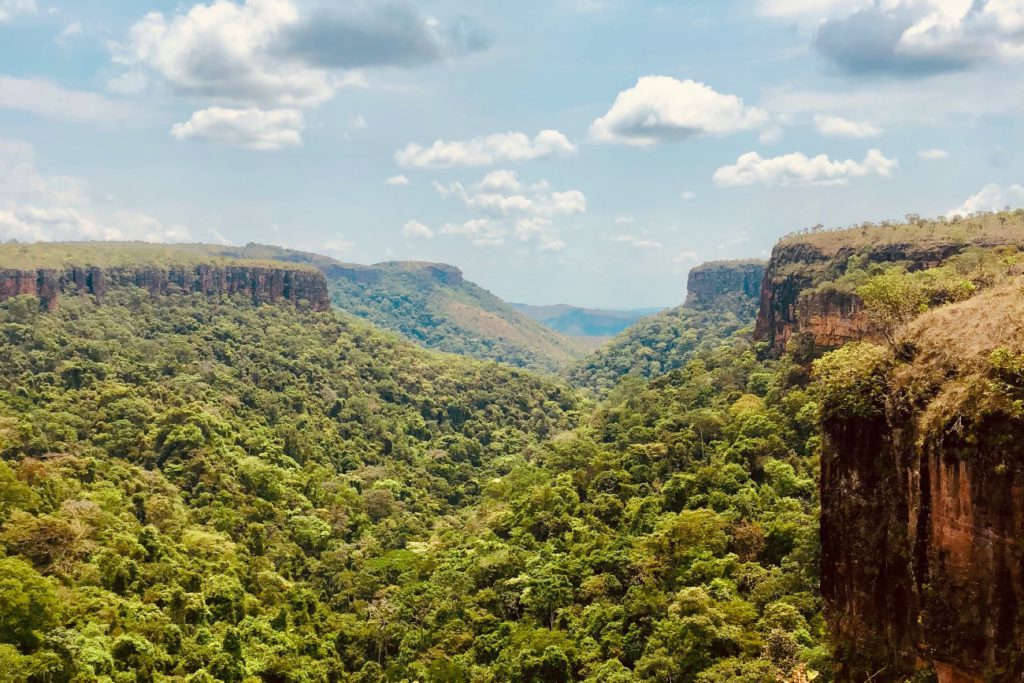
About TourHero
TourHero is a social travel platform that enables you to travel with like-minded people and fall in love with the journey. We work closely with handpicked local operators to ensure every experience curated is unique and exclusive to your travel group. Come with us on epic adventures and create memories that last a lifetime. Get started here!
